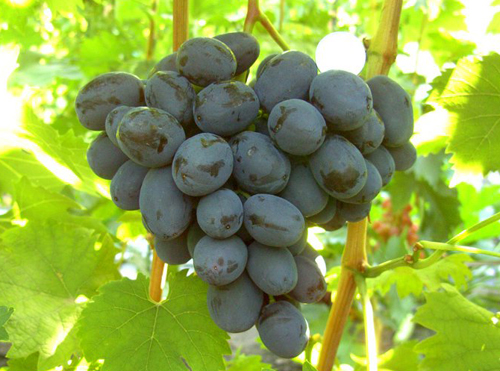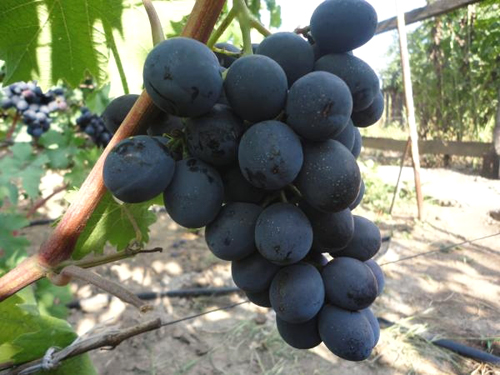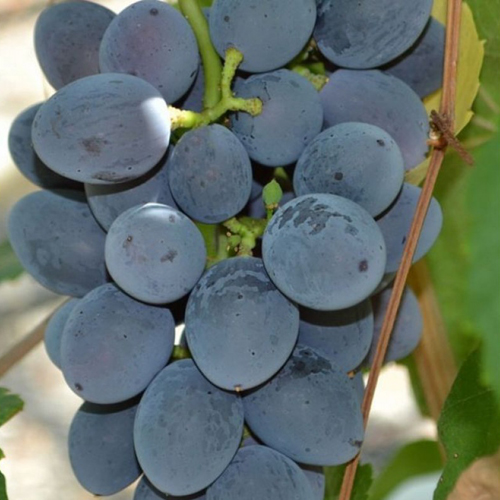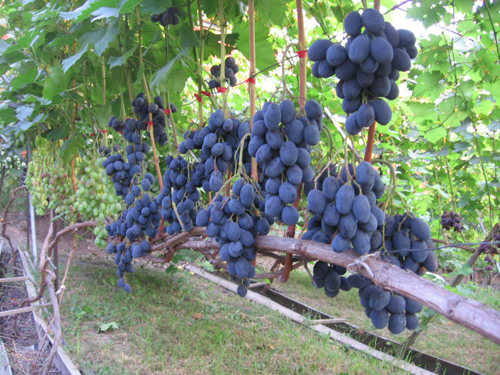Ruslan grape variety
The variety of varieties and hybrid forms of grapes over the past few decades has been replenished with a significant number of new wonderful varieties, the authors of which were not venerable scientists from various research institutes, but simple winegrowers, or, as they are also called, folk breeders. The most productive domestic enthusiasts in this field are Viktor Krainov, Evgeny Pavlovsky, Vasily Kapelyushny and some others. Many of their stunning works have become true bestsellers of the grape market, enjoying fantastic popularity with both amateur winegrowers and farmers.

In Ukraine, Vitaliy Zagorulko from Zaporozhye is rightfully considered one of such talented amateur breeders. His general experience in viticulture began in 1980, and from the 90s of the last century he began to conduct the first experiments on crossing different varieties and the subsequent selection of seedlings, distinguished by their external data and general economic qualities. Even Vitaly Vladimirovich's lack of specialized education did not interfere with the new business; the engineer by profession comprehended all the nuances of breeding work on his own experience. At the same time, he never chased after quantity, preferring to carry out a very high-quality selection, in order not only to amaze the imagination of buyers of seedlings with large-fruited and marketable grape bunches, but also to achieve any significant resistance of plants to pathogens, as well as their general unpretentiousness. This approach has borne fruit, and today Vitaly Zagorulko's assets include very attractive and original hybrid forms with a very decent set of economic qualities. I would like to hope that over time they will pass the state variety test and will be officially included in the State Register of Varieties, but now these novelties are of great interest among fans of the "sunny berry" from the farthest corners of the post-Soviet space, and also regularly win at various competitions and exhibitions.
One of these promising hybrids is Ruslan - the result of crossing the famous Gift to Zaporizhzhia with the Kuban variety, bred by the Anapa zonal experimental station of viticulture and winemaking. It is distinguished by high yield, very early ripening, excellent size, color and taste of fruits, increased resistance to diseases and frost, as well as good indicators of keeping quality and transportability. Of the shortcomings, only a certain risk of cracking of grape berries during ripening in the event of prolonged rains during this period or a sharp change in soil moisture can be noted.

Agrobiological characteristics
The vigor of the bushes is high. The crown of a young shoot is green, without bright anthocyanin tones, but slightly whitish due to the existing tomentose pubescence. Ruslan's leaves are large, rounded or somewhat elongated in length, consist of five lobes, and have an average or strong degree of dissection. The surface of the leaf blade is reticulate-wrinkled, the color depends on the growing conditions, and, first of all, on the fertility of the soil - it can be both pale green and very saturated. The upper lateral notches are deep, closed, with an ovoid lumen, or open, lyre-shaped with a rounded bottom. The lower notches are noticeably smaller, most often in the form of a reentrant angle. The petiole recess can also be closed or open. In the first case, it is characterized by an oval lumen, and in the second - a lyre-shaped form with a pointed bottom. Petioles are rather long, green with longitudinal red stripes. The denticles of vine leaves are irregular, triangular with slightly convex edges, medium width at the base and sharp tops. The flowers of the variety are bisexual, due to which pollination occurs confidently with its own pollen. Peeling of berries is almost never found.Ripening of Ruslan's vine is early and complete. At the same time, the annual growth turns yellowish-brown with slightly darker areas in the area of the nodes.
Clusters are large, conical, sometimes winged, of moderate density. The average weight of the hand ranges from 600 to 900 grams, while the most prominent ones reach 1.5 kg. The stems of the ridges are greenish-red in color, of medium length, strong enough to withstand the weight of the bunches. The berries are very massive, oval, dark blue in color with a thick waxy bloom on the surface, their weight is 12-16 grams, some up to 20 grams. They are not bad evenness, which makes the brushes look very attractive. The pulp of the variety is dense, crispy, pleasant in consistency, with a harmonious combination of sugar and acid and bright tones of plum on the palate. The content of glucose and fructose in Ruslan juice is 17-18 grams / 100 ml, of titratable acids - 6-7 grams / liter. The skin is rather thin, bursting when chewed, almost not felt during eating. The seeds in the berry are present in small quantities - only one or two, and, due to the significant size of the grapes, they do not have a negative effect on gastronomic properties. The grape tasting ratings are very high.

The crop is used mainly for fresh consumption, which, however, does not exclude the possibility of its use for harvesting for the winter. It produces compotes, jams and preserves, very elegant in color, which, moreover, have a unique taste. The variety can be interesting in commercial production due to its early ripening and high presentation of the bunches, which are in good demand on the market, especially since there are not so many early dark-colored varieties in the arsenal of winegrowers. In this regard, Ruslan has every chance to occupy his niche in the range of farms. The harvested grapes perfectly withstand long-distance transportation without deterioration of the excellent appearance and taste, and for a certain time can be stored in refrigerated chambers, cellars or cellars at a temperature of + 2 ... + 4 ° C and low relative humidity.
Removable ripeness at Ruslan in the south begins in late July - early August. The variety is characterized by rapid coloring of berries and their softening, which makes them edible much earlier than the accumulation of optimal gastronomic conditions. That is why the bunches of the first gatherings can lose to the taste of the later ones. However, the growing season for this variety is considered to be very short - 105-110 days from the moment the buds open, until the beginning of fruit ripening. The required sum of active temperatures is 2200-2300 ° C, which allows the hybrid to grow not only in traditional wine-growing regions, but also much further north. In this case, you will need to take care of protecting the aboveground part of the bush from frost in the winter. The minimum temperature that plants can tolerate without damage is -24 ° C.
After ripening, the grapes can continue to hang on the bushes for a considerable period of time, however, it is necessary to take into account its tendency to cracking in case of high soil moisture or a sharp drop in it. In addition, wasps can also damage berries, for which a thin skin is not any significant obstacle. This fact must also be taken into account when cultivating this variety.

And, of course, one cannot fail to note the high yield, which Ruslan demonstrates without any signs of overload. Adult bushes easily "pull" the load up to 20 kilograms of grapes, and subject to high agricultural technology, watering and regular feeding, this figure may be higher. Excellent productivity is due to a significant proportion of fruitful shoots (70-80%) and the large size of the ripe brushes themselves. The fruiting factor of the variety is also quite high - 1.2-1.4, but it is precisely this that needs to be limited, since the presence of more than one bunch on the shoot negatively affects both large-fruited and the ripening of the crop.An additional bonus is the opportunity to receive, albeit modest, but the second grape harvest for the season, formed on the stepchildren. He manages to mature, however, only in warm southern regions.
Agrotechnical features
Ruslan, unlike many of his fellows in amateur breeding, is characterized not only by excellent external data, but also by good resistance to diseases, unpretentiousness to environmental factors and high plasticity, which allows him to get excellent yields in a wide variety of climatic conditions. It shows itself equally well in the sultry south and in the regions of the middle zone, does not show any special preferences in relation to the mechanical composition and fertility of the soil, it is quite drought-resistant, but is afraid of a sharp change in dry and wet periods, and is also not able to grow normally in excessively damp conditions ... Cold places of growth, such as lowlands and northern slopes, where the risk of damage by recurrent spring frosts is high, and the conditions are, in principle, far from suitable for grapes, are not suitable for him.
Ruslan propagates very easily by cuttings due to its excellent rooting ability, but this method is possible only where the soil is free of phylloxera. In the case of planting grapes in the zone of infection with this dangerous pest, it is necessary to use seedlings based on phylloxera-resistant rootstocks. The feeding area is traditional for vigorous varieties - 5-6 square meters. The row spacing with a vertical garter of one-year growth is 2.5-2.75 meters, the distance between bushes in a row is 2-2.25 meters.
The bushes management scheme depends on the frost hazard of the climate, and the presence or absence of the need to cover the vine for the winter. Ideal for Ruslan can be considered a high-standard formation, in which the plants have a large supply of perennial wood, which has a positive effect on the size of the bunches and the yield in general. However, this option is possible only in traditional wine-growing regions, where the thermometer does not fall below the critical values for the variety. In more northern latitudes, it is already necessary to form grape bushes according to standard-free schemes, thanks to which the vines are removed from the trellis in autumn without damage and sheltered for the winter. The insulation method also depends on the minimum winter temperatures. If we are talking about moderately cold regions, then it will be enough just to bury the aboveground part of the bush for the winter in the ground. In this case, tunnel film shelters show themselves quite well, under which, in the presence of snow cover, in cold weather it turns out to be immediately warmer by 6-8 degrees than in the open air. In the most severe conditions, in order to preserve the viability of Ruslan's vine, multilayer shelters made of scrap materials - straw, shavings, spruce branches, reeds, etc., with external waterproofing with roofing felt, film or wooden shields will be required in order to prevent the entire structure from getting wet with melt water.
The organic insulation used in winter during the subsequent growing season can be used as a mulch layer to protect the soil from severe drying out, and hence a sharp change in its moisture content, which is why this variety often cracks ripening berries. It is possible, of course, to maintain optimal soil moisture with the help of regular watering, but in the absence of such an opportunity, mulching can be a way out of the situation.
Pruning of fruiting grape bushes is carried out to moderate values. On average, 30-40 eyes are left on the plant, and the fruit arrows are shortened by 6-8 buds. The final regulation of the load is carried out during the debris, as well as when removing excess inflorescences on the shoots.After the first procedure, only strong fruitful vines should remain on the Ruslan bush, a total of 20-24, and then only one, the most powerful inflorescence, is left on each shoot. It is also worth noting that these figures for the load are not the only correct ones, and can change up or down depending on the specific conditions: the scheme of the bush, its vital energy, the provision of moisture and mineral nutrition, the level of agricultural technology
In relation to fungal diseases, Ruslan shows himself on the good side. To the most harmful of them - mildew and powdery mildew, the variety demonstrates resistance at the level of 3 points, which means the possibility of obtaining a crop with a minimum number of preventive chemical treatments. They will be required without fail only in the most critical phases of the growing season - before and after flowering, and then the winegrower will need to control the situation in the vineyard, only reacting pointwise to rare cases of pathogens. In terms of combating pests, special attention should be paid to wasps, which can cause significant damage to the crop. In order to protect it reliably, it is advisable to place each bunch in a special bag, where it will be in absolute safety. If the volumes of grapes are too large and individual protection seems difficult, then you will have to fight insects by destroying them, for which special traps are used, or open containers with sugar syrup are placed around the vineyard, where wasps drown en masse.
If these conditions are met, it will be possible not to hurry with the harvest, allowing Ruslan to fully recruit his wonderful conditions, and to reward the grower with an excellent quality harvest for his care.









I live in the Orenburg region. We took off the first crop of Ruslan. Full delight! Very large (15 g), the bunch is aligned, the bones are not felt. Doesn't get sick, ripens well. Beautiful grapes! I can’t believe that we have grown so much in our region.